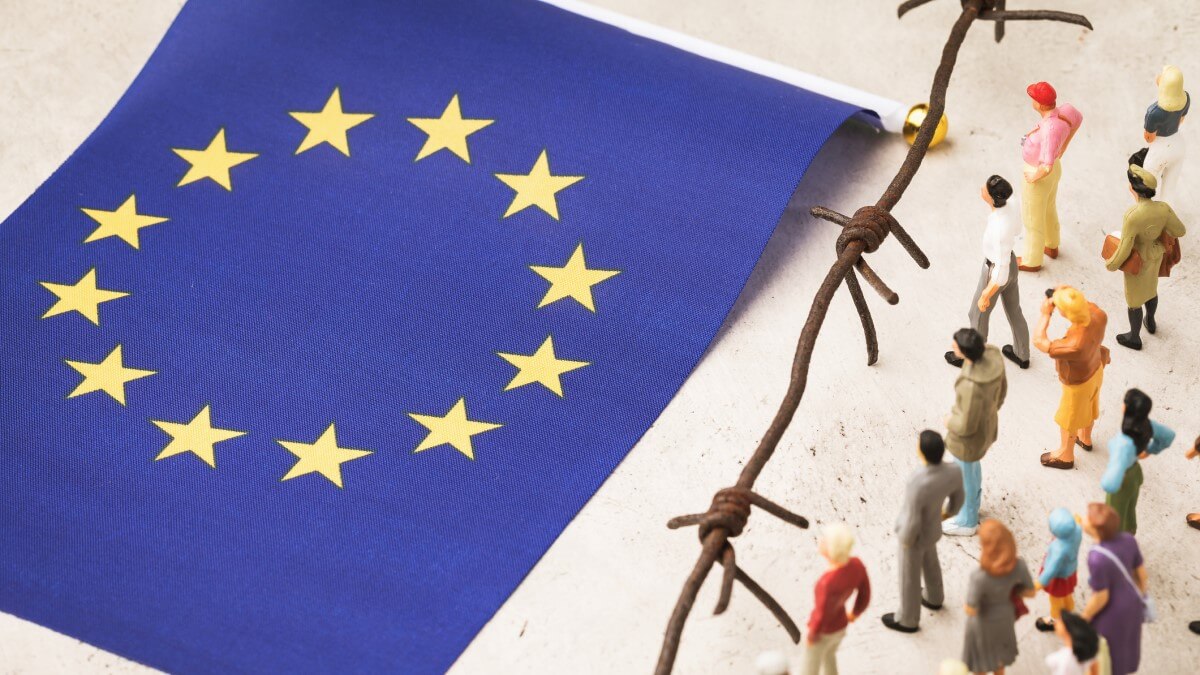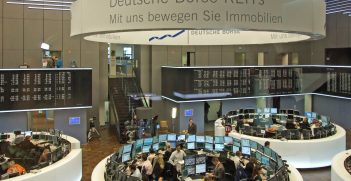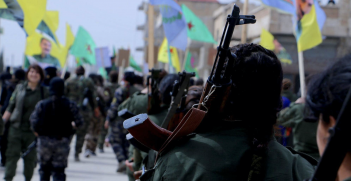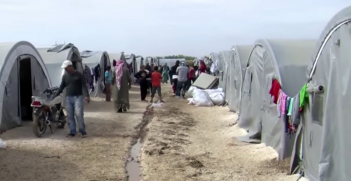A New Way Forward or More of the Same? The EU's Responses to the Syrian and Ukrainian Asylum Crises

As the conflict in Ukraine continues, the European Union’s response to the arrival of Ukrainian asylum seekers has come under increasing scrutiny given its contrast with the 2015 Syrian asylum crisis. Does the more welcoming reception of Ukrainian asylum seekers mark a progressive turning point in EU asylum governance?
The marked difference between EU and member state governance responses to the 2015 Syrian and 2022 Ukrainian asylum crises provides deeper insights into the drivers of EU asylum governance choices now and into the future.
What was the EU’s response to the 2015 Syrian asylum crisis?
Civil and political unrest in the Middle East and North Africa in the early 2010s precipitated the largest movement of forcibly displaced people to Europe since WWII. In 2015, almost 1 million asylum seekers, the majority fleeing conflict in Syria, arrived before the end of the year. Germany and Sweden accepted the most asylum seekers, with 1.2 million arriving in Germany by the end of 2016. Despite the high number of arrivals accepted by these nations, other countries, such as Poland, Hungary, and the Czech Republic, refused to accept asylum seekers. The EU institutions relied on the Common European Asylum System to manage asylum administration, this was most notably under the Dublin Regulation framework. This placed a high administrative burden on member states at the periphery of the EU, especially Italy and Greece. Pressure on national asylum systems, combined with high profile and politicised events such as the Paris attacks, led to calls from politicians to decrease the number of arrivals.
To reduce the number of asylum seekers travelling to Europe, the EU pursued a strategy of externalisation. This aimed to keep asylum seekers at the periphery of the EU, intercepting boats on the Mediterranean Sea, and blocking the Western Balkan migration route. Many member states also reintroduced border controls, citing security concerns as the reason for the reintroduction of controls. Supranational agreements with third-countries, such as Turkey and Libya, provided states with incentives and support to prevent asylum seekers from reaching Europe.
How does the EU’s response to the 2022 Ukrainian asylum crisis compare to 2015?
In 2022, more than 6 million people fled conflict stemming from Russia’s invasion of Ukraine. As of August 2023, 5.2 million Ukrainians had applied for asylum or temporary protection in the EU and neighbouring countries. All EU member states currently host Ukrainian asylum seekers. Germany, Poland, and the Czech Republic have accepted the most refugees, with Germany and Poland each currently hosting about 1 million Ukrainians.
Instead of pursuing an externalisation strategy, the EU’s response to has been one of solidarity and internal management. This is especially apparent in the Commission’s unprecedented activation of the Temporary Protection Directive (TPD). The TPD obliges EU member states to provide Ukrainian refugees with the rights to reside, seek employment, attend school, and travel freely within the EU for up to three years. According to the Council, the purpose is to “provide immediate and collective protection” for Ukrainians and “reduce pressure on the national asylum systems” of member states. Although member states faced similar pressures during the 2015 crisis, the TPD was notably missing. Instead, EU institutions and member states sought to control refugee flows by keeping asylum seekers out of the EU or confined to the periphery of the block via the Dublin Regulation. The 2022 activation of the TPD represents an exceptional shift in EU member state solidarity in asylum governance towards responsibility sharing.
Although asylum seekers from other countries continue to travel to the EU, Ukrainian asylum seekers are often given special treatment. Ukrainian nationals are frequently allowed to quickly cross borders into the EU whereas nationals from other countries must wait for long periods of time before they can cross. Boats continue to traverse the Mediterranean, carrying asylum seekers from Africa and the Middle East. These boats are often intercepted and turned back. Many boats do not complete the journey, with the International Organization for Migration reporting that in 2022, 2,411 people died or went missing attempting to cross the Mediterranean. Despite these deaths, the EU and its member states continue to pursue a policy of deterrence. In 2023, the Italian government passed legislation inhibiting NGO assistance for migrant boats in distress (in an attempt to deter future boat journeys), while the Greek coastguard continued to push back asylum seekers crossing from Turkey.
Why were the responses to Ukrainian and Syrian asylum seekers so different?
EU member states have been criticised for appearing to be more welcoming to Ukrainian asylum seekers than others. Many scholars, journalists, and humanitarian NGOs have accused the EU and some member states of being racist and Islamophobic in their responses. Ukrainian asylum seekers are predominately Christian, whereas refugees from Syria are mostly Muslim. In 2015, Hungarian Prime Minister Viktor Orbán refused to resettle refugees in Hungary if they were not Christian or were not European. Hungary, as well as similarly restrictive Poland and the Czech Republic, have all accepted many hundreds of thousands of Ukrainian asylum seekers. The double standard of protection for Syrians and Ukrainians highlights the embedded religious and racial discrimination of some European migration policies which shape European responses to asylum crises.
Geopolitical differences between the crises matters too. The threat that Russian aggression represents to EU security demands EU action. Instead of viewing the situation as a primarily humanitarian crisis, as was the case in 2015, EU policymakers see the 2022 crisis as a geopolitical conflict. By demonstrating solidarity with the Ukrainian asylum seekers, the EU is positioning itself in opposition to Russia without directly becoming involved in the conflict. Further, many Eastern European countries share with Ukraine a post-Soviet history and fear of Russian aggression that inspires solidarity with Ukrainian asylum seekers. By contrast, conflicts in North Africa and the Middle East have not been perceived as similarly threating or geopolitically unbalancing. The EU and its member states therefore did not have the same geopolitical security pressures driving their responses to the asylum seeker arrivals as in 2022.
The EU also pursued a more welcoming asylum governance strategy in response to the 2022 crisis to construct and legitimise a more humanitarian European identity. In the wake of the 2015 crisis, the EU developed a negative reputation among political leaders, scholars, and humanitarian NGOs for failing to adequately and consistently welcome asylum seekers. This reputation conflicts with the EU’s core values of human rights and solidarity. To repair its reputation, the EU and its member states are incentivised to pursue more open and consistent asylum governance strategies that welcome rather than deterre those fleeing Ukraine.
What does this mean for the future of EU responses to asylum crises?
Although the EU’s response to Ukrainian asylum seekers appears unified and welcoming, especially when compared to to the 2015 asylum crisis, it remains to be seen if this solidarity will continue and if countries hosting large numbers of Ukrainian asylum seekers will continue to be welcoming. The use of hardline deterrence policies, especially through the imposition of boat pushbacks on the Mediterranean, indicates that the progressive approach to Ukrainian asylum seekers may be an aberration rather than a durable shift in EU asylum governance. Instead, this may be a symptom of a differentiated asylum system dependent on prejudiced interpretations of asylum seeker deservingness, geopolitical pressures, and potential EU reputational benefits.
Dr Kelly Soderstrom is an academic at The University of Melbourne, where she also completed her PhD in the School of Social and Political Sciences in 2022. Her current research explores the pragmatic and normative dimensions of German and EU asylum policy development in response to crisis, and the intersection of asylum governance and the private sector.
This article is published under a Creative Commons License and may be republished with attribution.





